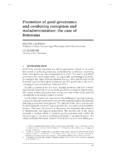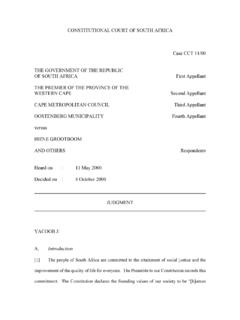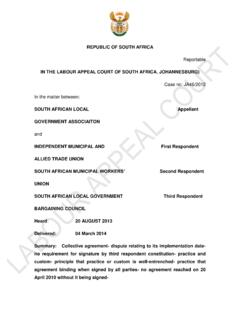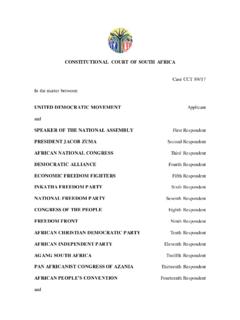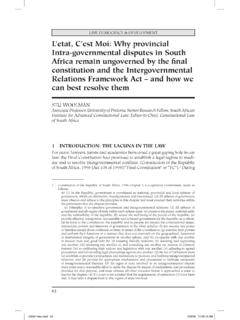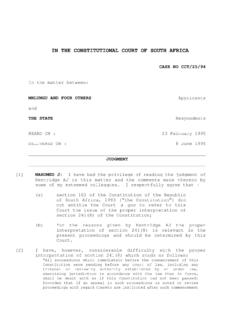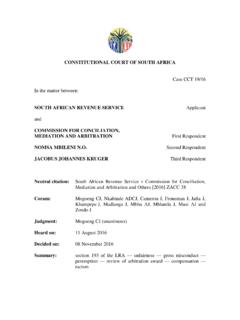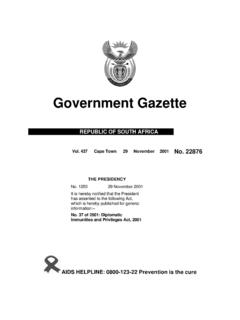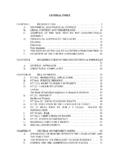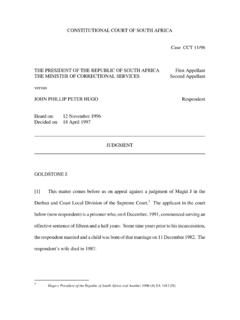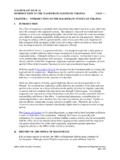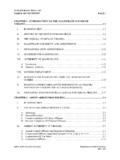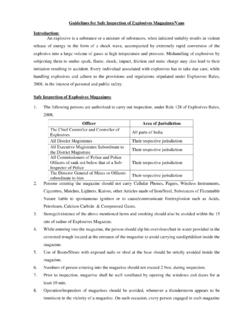Transcription of IN THE SOUTH GAUTENG HIGH COURT (JOHANNESBURG) …
1 IN THE SOUTH GAUTENG HIGH COURT (JOHANNESBURG) Supreme COURT Ref. No: 26/09 magistrate s Serial No: 27/08 Review Case No: B/DH3625/08 14 April 2009 magistrate ROODEPOORT THE STATE v ERIC SIKAKANE REVIEW JUDGMENT MOSHIDI J.
2 INTRODUCTION: [1] This matter was placed before me on review by the Aspirant magistrate at Roodepoort. [2] The grounds for review were articulated by the Aspirant magistrate in her covering letter as follows: I have noted the following irregularities and note same for the Honourable Judge s attention: 21. That the sentence imposed is incompetent as it stands. It should have read :- Fined or 6 months imprisonment, half of which is suspended for 5 years on condition that the accused is not again convicted of assault, committed within the period of suspension; 2.
3 That I had inadvertently failed to appraise the accused of his review rights and appeal rights. THE FACTS OF THE MATTER [3] Briefly stated, the facts were as follows: The accused, who elected to conduct his own defence, was charged in the COURT below with the offence of assault with intention to do grievous bodily harm. This was indeed the charge put to the accused at the commencement of the trial. [4] Prior to dealing with the plea of the accused, and what transpired thereafter, it was essential to point out what follows.
4 The reasons advanced by the Aspirant magistrate for the review are not the only reasons. There was indeed another reason. This pertained to the correctness of the conviction itself. This COURT deemed it necessary to deal with the conviction mero motu as discussed below. 3[5] The accused pleaded guilty to the charge. He was duly questioned by the Learned magistrate in terms of the provisions of section 112 (1) (b) of the Criminal Procedure Act, No 51 of 1977. Notwithstanding the fact that the answers provided by the accused during questioning by the Learned magistrate did not amount to an unequivocal admission of the offence, (assault with intent to do grievous bodily harm)
5 , and the fact that the state prosecutor in fact accepted a plea of common assault, namely, assault with intent to do grievous has the Learned magistrate nevertheless proceeded to convict the accused as charged namely, assault with intent to do grievous bodily harm. In this regard, the record read: The COURT is satisfied that you have admitted all the elements, you are then found guilty as charged on the plea of guilty This finding of Learned magistrate was clearly incorrect and therefore incompetent.
6 For the sake of illustration, the record of the proceedings page 3 lines 22 24, reflected the accused s reply to questioning as follows: So as I was resting on the bed again she kept on talking and all that. This is when I pushed her with my foot on the thigh. I didn t actually kick her . Further exchange between the Learned magistrate and the accused revealed the following: COURT : and do you admit that you were intentionally assaulting her with the intent to cause grievous bodily harm?
7 Accused: I wasn t intending to assault her. I just pushed her off. I was trying to stop her from talking because I really already stopped talking about it she carried on talking (record page 4, lines 6 10) 4 THE APPLICABLE LAW [6] It is trite law that in principle, there was a clear distinction between common assault and assault with intention to do grievous bodily harm. In respect of the latter, the Learned author, CR Snyman, In Criminal Law 4th edition at page 435, said All the requirements for an assault set out above apply to this crime, but in addition there must be intent to do grievous bodily It is simply the intention to do such harm that is in question.
8 The position was succinctly set out in S v Dipholo 1983 (4) SA 757 (T) at 760, where the COURT summarized the situation as follows: On a charge of assault with intent to do grievous bodily harm, the question arises whether the state has proved beyond reasonable doubt that the accused had the required intent (to do grievous bodily harm). That is a question of fact which must be decided on the basis, inter alia, of the following factors: (a) The nature of the weapon used and in what manner it was used ; (b) The degree of forced used and how such force was used; (c) The part of the body aimed at; and (d) Also the nature of the injury, if any, which was sustained.
9 In S v Mbelu 1966 (2) PH. , the Honourable Miller J said: Now where the COURT is confronted with the problem whether if should draw the inference that an assault was accompanied by this particular intent it usually has to rely on four main factors which provide the index to the accused s state of mind. I am not suggesting that these four factors are exhaustive; I do suggest that in the large majority of cases these are the 5factors which provide a guide to the accused s state of mind.
10 They are, first, the nature of the weapon or instrument used; secondly, the degree of force used by the accused in wielding that instrument or weapon ; thirdly, the situation on the body where the assault was directed and fourthly the injuries actually sustained by the victim of the assault .. See also S v Mdau 2001 (1) SACR 625 (W). [7] In the present matter, and for what may become relevant latter, there was no weapon or instrument used by the accused. The charge sheet alleged that he kicked her.
